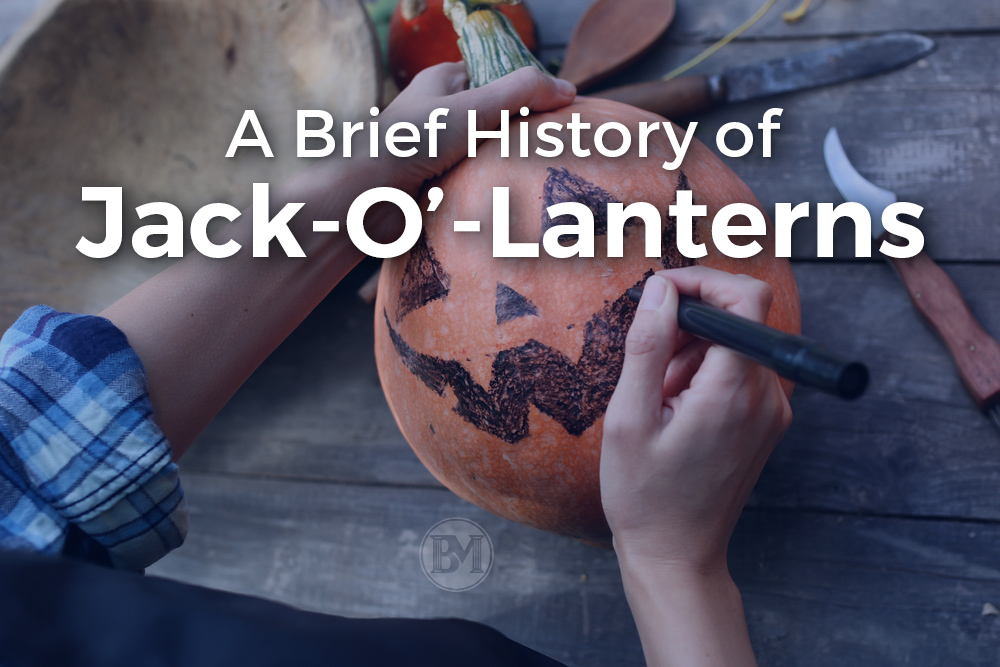
The term “jack-o’-lantern” was first applied to people, not pumpkins. As far back as 1663, the term meant a man with a lantern, or a night watchman. Just a decade or so later, it began to be used to refer to the mysterious lights sometimes seen at night over bogs, swamps, and marshes.
The term originates as early as 1663, but no-one using it at the time had likely ever seen an orange pumpkin. Just like the term “jack of all trades” implies, a “jack-o’-lantern” was a man who carried the lantern to keep watch at night. Not too many years later, the term was used in jest to add lightheartedness when describing mysterious lights seen over wetlands at night. People used to tell stories to explain these lights, and as early as the 1500’s, the Irish stories often involved a character named Jack.

The Legend(s) of Stingy Jack
The stories portrayed Stingy Jack as a blacksmith who invited the devil to a drink. Jack, being stingy, concocted a strategy to relieve himself of the responsibility to pay for the drinks and convinced the devil to transform himself into a coin which could be used to pay the tab. The devil now in the palm of his hand, Stingy Jack walked out on the tab and placed the coin into his pocket with a silver cross to prevent the devil from transforming back. Bargaining with the devil to not take revenge on Jack or claim his soul upon his deathbed, he released the devil from his pocket-sized prison.
Another tale tells of Stingy Jack outwitting the devil once again, when he connivingly talked him into climbing a tree to pick fruit. During the devil’s venture into the canopy, Jack carved a cross into the trunk to prevent the devil from descending back again. Just as at the last, Jack bargains for his safety from revenge and possession of his soul before finally permitting the devil to climb down to stable ground from the tree’s branches.
At the last, Stingy Jack passed away, and his spirit found no rest. He was not allowed into heaven, and the devil honored his vows to deny ownership of Jack’s soul at hell’s gate, and gave him a glowing coal before sending him into the darkness of night to find a hell of his own. Upon receiving this burning ember, Jack placed it into a carved out turnip to roam the earth forevermore. The mystery lights of the Irish wetlands were attributed to Stingy Jack’s lantern’s motions as his wandering soul roamed the lands. The light and its supposed bearer were, together, called “Jack of the Lantern,” or “Jack O’Lantern.”

Stingy Jack Visits the New World
Back home in the British Isles, the tradition of making lanterns by carving turnips, beets, or potatoes occupied by coal, embers, or candles was part of celebrating the fall harvest. Children were known to venture off the road with their make-shift lantern to trick passersby into believing that Stingy Jack or another lost soul was near.
In the new world, pumpkins were key in the survival of early settlers. The following poem gives the example:
For pottage and puddings and custards and pies
Our pumpkins and parsnips are common supplies,
We have pumpkins at morning and pumpkins at noon,
If it were not for pumpkins we should be undoon.”
Pilgrim verse, circa 1633
The abundance of pumpkins made them the perfect choice for Irish immigrants to carve into Stingy Jack’s lanterns. These new vessels became part of the tradition.

From European Legend to Seasonal Decor
In time, children began carving crude faces into them to make them more frightful. The carved face and legend of Jack merged by the mid 1800’s when the carved glowing pumpkins were finally called jack-o’-lanterns.
In 1892, the Mayor of Atlanta included jack-o’-lanterns used as decorations for a Halloween party. Several pumpkins with carved faces and inner lights were placed around the premise, and entered into the American tradition of the modern jack-o’-lantern.
See our related articles:
Simple Pumpkin Carving for the Whole Family,
Easy and Free Pumpkin Carving Stencils, and
5 Easy Tips for Fall Decorations.
inspired by: http://mentalfloss.com/article/12865/whats-origin-jack-o-lanterns
